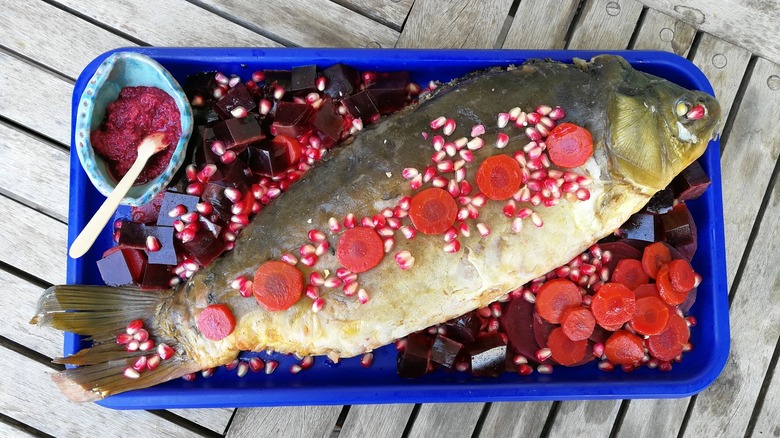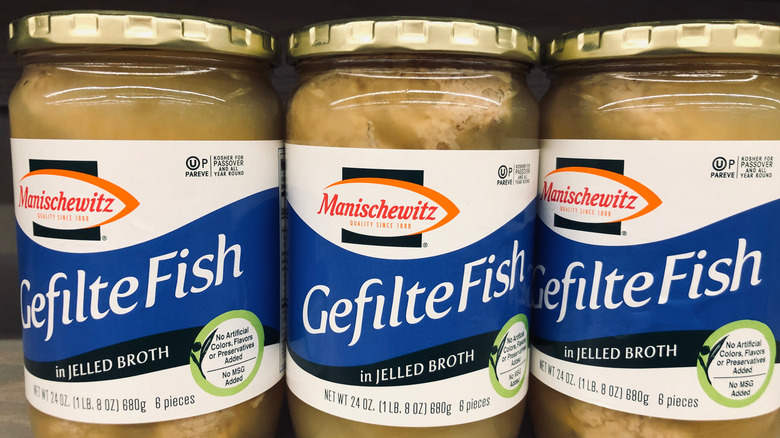Gefilte Fish: The Jewish Delicacy With Medieval Origins
As much of a delicacy as it is a culinary mystery for those unfamiliar with it, gefilte fish (pronounced "guh-fill-tuh") is a stuffed fish that is an important part of Jewish culinary tradition. Love it or not, gefilte fish is a staple dish served on significant Jewish holidays (per The Kitchn) with a history that spans hundreds of years. Surprisingly, though, dishes featuring gefilte fish have origins that are –- wait for it –- not Jewish, per STL Jewish Light. Nevertheless, it holds such a place of tradition in the Jewish culture that not to serve it on important dates, such as Passover or Rosh Hashanah, may be viewed as what Jewish Unpacked calls a shande or something extremely shameful.
Love it or not, gefilte fish has a staying power that is the stuff of legend, the kind of endurance that all dishes in the fridge aspire to have. There are certainly Jewish dishes even older than this one. In fact, compared to the thousands of years of Jewish history, gefilte fish is practically nouvelle cuisine. To find its origins, we must go back a mere 672 years.
The Gentile food that became Jewish
Gefilte fish comes from the Yiddish word meaning "stuffed fish," according to The Kitchn. True to its name, the first recorded occurrence of the dish that inspired gefilte fish is in "Daz Buoch von Guoter Spise," or "The Book of Good Food," written in Germany roughly around the year 1350 C.E., according to Serious Eats. The recipe is called gefuelten hechden, or stuffed pike. The fish is first poached and then the cooked meat is mashed and flavored. The mixture is then stuffed into the fish skin before the whole dish is roasted. Serious Eats points out that the dish was originally popular, not among Jews but Catholics during Lent.
During the Middle Ages, gefilte fish was a perfect addition to the Jewish observance of Shabbot. According to STL Jewish Light, it symbolized fertility and the forthcoming Messiah. Fish were also plentiful for Eastern European and German Jews, who had plenty of water sources accessible to them. Additionally, the recipe could be made in advance, which was vital, as the practice of cleaning bones from fish is forbidden during the Sabbath. So gefilte fish could be prepared on Friday, preserved until Saturday, and eaten with no bones to worry about. According to Serious Eats, gefilte fish began taking the form that we are most familiar with today in the 17th century as Jews developed their own "cooking hack" by shunning the whole stuffed fish in favor of turning the fish mixture into dumplings.
The dish with staying power
Per Serious Eats, these dumplings of the 17th century consisted of chopped fish, matzo meal, and eggs. When the dish emigrated to the United States, it inevitably morphed into different variations depending on local ingredients and family traditions. Today, we see gefilte fish recipes containing the aforementioned elements but with the addition of more flavorings and even multiple types of fish. In the early part of the 20th century, it wasn't unusual for Jewish families to begin preparing for the Sabbath's gefilte fish days ahead of time. With the lack of mass refrigeration, the best way to preserve their fresh fish was, well, in water. So, bathtubs became the best place to store their catches until the dish could be prepared, per STL Jewish Light.
As you can imagine, there had to be a better way. Sidney Leibner was the man responsible for canning Mother's Fish ready-to-serve gefilte fish just before World War II, delighting Jewish families everywhere. Several other companies followed suit after that and, thus, began one of the most undesirable (but still popular and convenient) and longstanding items to sit in the marketplace. It may be unsightly, but there the jars sit, knowing they're not going anywhere anytime soon.
Better than it looks
For the gefilte fish newbie, you may ask yourself, "But, why is this a good food source?" Like many dishes with cultural ties, gefilte fish is steeped in tradition, history, and has a deep meaning to those who eat it. Traditionally, the gefilte fish dumplings are sliced and served chilled with a slice of carrot as a garnish and accompanied by horseradish, but today there are a number of ways to enjoy this dish.
Renowned appetizing shops like Russ & Daughters in New York City offer their versions. There are even recipes to turn the fish dish into sushi (per Kosher). Recipes range from sweet or savory or chock full of herbs. You're still most likely to find it served on a Jewish holiday table, but some Catholics (especially in Poland, per The Kitchn) still eat it around Christmas. According to Jamie Geller, there are now so many ways to eat gefilte fish, either homemade or out of the jar, that you really can prepare it any time of year for anyone to enjoy.



